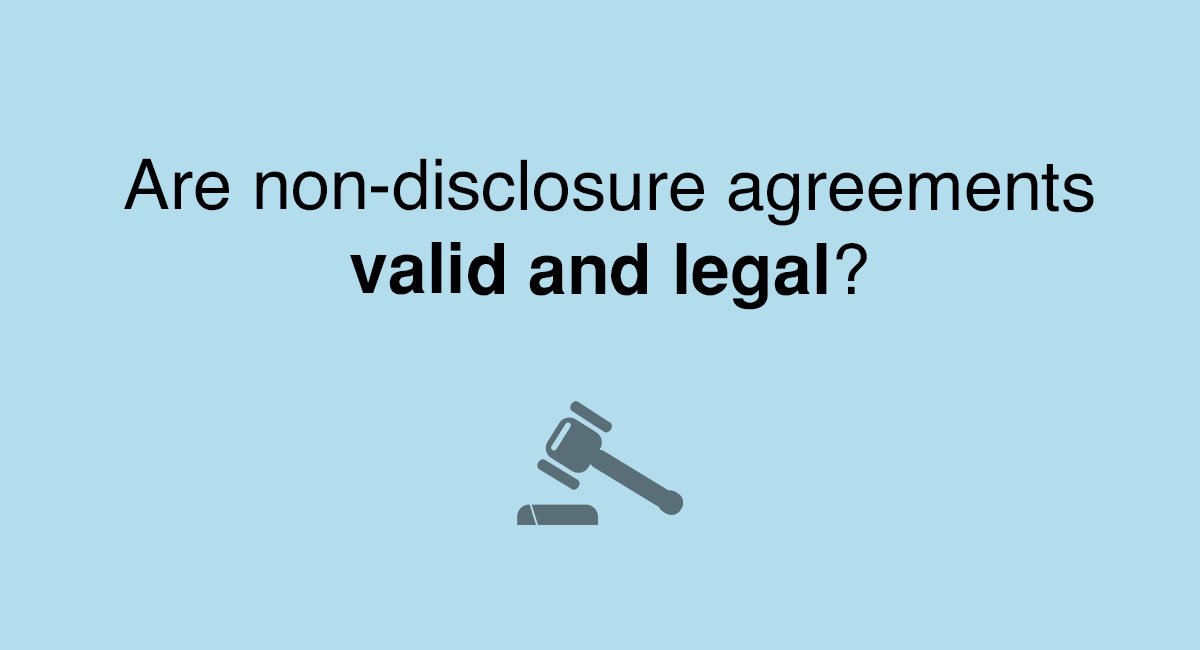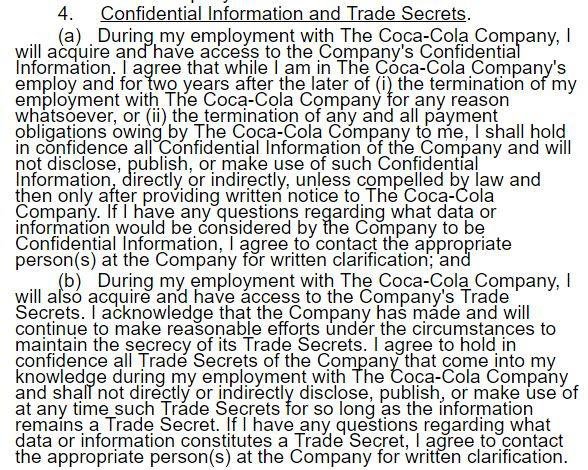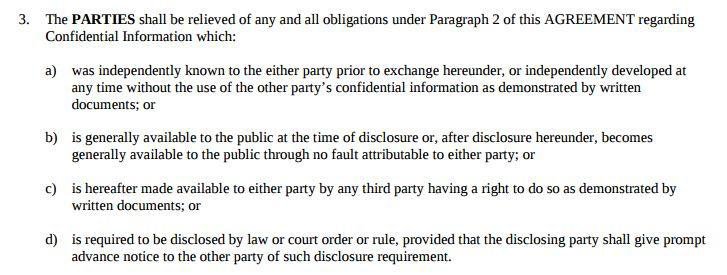Are non-disclosure agreements valid and legal?

Non-disclosure agreements (NDA) have almost become synonymous with the protection of confidential information. This type of agreement is basically a legal contract that expressly prohibits the disclosure or use of proprietary information without permission.
But what makes a non-disclosure valid and legal?
Although not often accepted by venture capitalists and most startup-up investors, non-disclosure agreements are normally popular in companies that are highly prolific in coming up with new inventions and innovations (such as Apple, Hewlett Packard and Microsoft), startups, enterprises that operate on trade secrets such as Coca-Cola and KFC and other entrepreneurs that own proprietary information.
Contents
Non-disclosure agreements are usually signed before parties start negotiations for joint ventures, potential licensing relationships, distribution relationships, independent contractor relationships and also found in franchising arrangements, employment hiring situations and merger and acquisition processes.
Elements of a contract
Since the non-disclosure agreement is basically a contract, it’s useful to consider whether you’re fulfilling the basic legal elements that make up a contract when you’re creating this agreement.

For example, in the UK, the key elements of a contract are:
- The offer. One party has to make an offer of willingness to enter into a contract with the intention to be bound by the terms of the contract, if accepted by the other party.
-
The acceptance. The other party must understand the terms of the contract and accept them.
There’s no acceptance if the parties are still in negotiation.
Until the contract is officially signed, parties have the right to change their minds and withdraw from negotiations.
- The consideration. Consideration is the element of mutuality where both parties give something to the other as a promise to enforce the contract.
- The intention to create legal relations. This is where the parties intend for legal consequences into the contract.
-
The certainty and completeness. Both parties need to be clear and understand the terms of the contract.
The parties must also reach agreement on all the major elements of the contract and there’s nothing left outstanding to be agreed upon.
- The capacity. The parties must be legally capable of entering into a contract. If signing as sole proprietors, the parties must also be at least 18 years old and must be of sound mind.

Compare this with the USA where the key elements of a contract are:
- The offer. An offer is a promise with intent to enter into a contract, conditional upon an exchange of an act, forbearance or promise by another party.
-
The acceptance. There must be an agreement by the other party to enter into the terms proposed.
Requests to change the terms of the contract would constitute a counteroffer. Counteroffer is not acceptance.
The acceptance must be communicated by the other party or by an authorized representative of the other party.
- The consideration. Consideration is either a benefit to the promisor or detriment to the promisee and need not be monetary.
- The legal purpose/subject matter. The contract must be for a legal purpose and cannot be dealing with an illegal subject matter.
- The mutuality of obligation. There must be agreement to the major terms of the contract and both parties must be bound to their promises.
- The competency and capacity. Parties must be at least 18 or 21 (depending on jurisdiction), competent and of sound mind, not intoxicated and have authority to enter into the contract they will sign.
As you can see there are huge similarities between the elements of a contract between the two countries.
Now let’s look at how the elements of a contract are applied in examples of various non-disclosure agreements.
Offer and acceptance
The parties may verbally agree to execute a non-disclosure agreement. The confirmation of offer and acceptance of the agreement will be seen through the signature of the parties on the agreement.

Consideration
As mentioned above, “consideration” can be in the form of a benefit to the promisor and/or a detriment to the promisee.
Often the sharing of valuable confidential information from the Disclosing Party to the Receiving Party is evidence of a benefit to the Receiving Party.
Alternatively, the consent from the Receiving Party to not disclose confidential information or use the information without permission can be considered a detriment.
Intention to create legal relations
As non-disclosure agreements are normally created in a commercial context and it’s not done as a domestic or social arrangement, it’s safe to assume that there are intentions to create legal relations through this type of agreement.
Legal purpose/subject matter
The proposed business transaction between the parties for which the non-disclosure agreement would be signed for obviously has to be legal.
A NDA with proposals to defraud the government obviously would be an example of an illegal subject matter to have in this kind of agreement.
However, it’s also important to assess the scope of your agreement to ensure that the purpose of your NDA does not come foul of applicable laws.
For example, some jurisdictions take a harder stance against anti-competition clauses than other jurisdictions. In cases where the courts thought that the non-disclosure agreement placed an illegal anti-competition restriction on the Receiving Party such as in the case of Everett J. Prescott, Inc. v. Ross, the court did not voice support for those kind of clauses (that prevent an employee from future job prospects).
As a result, ensure that when you create your NDA, that you adhere to the laws that will be applicable to the agreement. Otherwise, the courts may declare the entire agreement unenforceable.
Certainty and completeness
It’s good practice to bring major points of the agreement to the Receiving Party’s attention to ensure that they understand what the obligations are in the non-disclosure agreement they will sign.
Article 25 of the Brussels regulation requires that there is consensus reached between parties on the jurisdiction of the agreement.
If the Receiving Party resides within the European Union, then to ensure that there’s clear evidence that the Receiving Party agrees to the jurisdiction clause you drafted for the agreement.
You should also ensure that you give the Receiving Party a reasonable time period to seek legal advice before signing.
Competency and capacity
All parties must be at least 18 years old, be of sound mind and not be intoxicated when signing the agreement. The person signing should also have legal authority to contract on behalf of the party.
A clause that you should use in your NDA is like the one below taken from Canadian Corporate Counsel Association’s Mutual Confidentiality and Non Disclosure Agreement template:
![]()
On top of this, in the signing area, you should have a line or two allowing the person signing to denote their title and capacity on behalf of the Receiving Party.
This helps avoid the situation of a person signing in their own personal capacity, unless they are a sole proprietor operating in their own name.

Mutuality of obligation
Both parties must be bound to their promises.
Here’s an example of a clause indicating that the agreement is binding taken from Accuride Corp’s Confidentiality and Non-Disclosure Agreement:

Don’t forget to include a clause indicating legal remedies in the event of a breach such as the one below taken again from the same example as above:

On top of these pointed out above, it’s important that you include other clauses to ensure that your non-disclosure stands a higher chance of being upheld by a court of competent jurisdiction, if ever challenged.
Additional clauses
Clause #1 – Scope of Confidential Information
The Disclosing Party is normally given the freedom to specify what information will be considered confidential but it’s important to ensure that your scope is not too vague and broad.
Confidential information can be limited to written information only or you can choose to extend it to verbal information as well.
However, it’s much harder to prove in court that confidential information was shared (and disclosed in breach of the NDA) if there’s no written evidence.
Therefore, you may prefer to include a practice of transferring whatever is said verbally into a written form that you can mark as confidential and give to the Receiving Party while keeping a copy for your own records.
The same Accuride Corp’s Confidentiality and Non-Disclosure Agreement shows what the agreement considers it is “confidential information”.

Clause #2 – Duration
Courts tend to disfavor non-disclosure with an unlimited perpetual duration, unless the information being shared is considered a trade secret.
Trade secrets normally gain a higher protection than merely ordinary confidential information because it possesses inherent commercial value based on the secret being kept and confers some sort of economic benefit to its owner. Furthermore to qualify as a trade secret, reasonable effort must be made to keep the trade secret confidential at all times.
If, however, some of your disclosures are merely ordinary confidential information that do not quality as trade secrets, then you should apply a finite time duration for the obligation of confidentiality.
This is because courts tend to frown upon non-disclosure agreements with perpetual time durations that merely involve ordinary confidential information.
For example, in Augusta Medical Complex, Inc. v. Blue Cross of Kansas, Inc., the Kansas court stated that it was against contracts with indefinite time durations.
If you intend to be sharing both ordinary confidential information and trade secrets, you can choose to have two distinct clauses with different time durations to cover the different types of information.
Here are some clauses from the Coca Cola’s Agreement on Confidentiality, Non-Competition and Non Solicitation where the disclosure period for ordinary confidential information is limited to two years after termination of employment but ongoing confidentiality is required for Coca Cola’s trade secrets:

Clause #3 – Exceptions to requirement for confidentiality
Below are some of the most common exceptions to the requirement of confidentiality in most agreements. These exceptions are generally used so that the non-disclosure agreement comes across as reasonable.
-
Information that the Receiving Party received from a third party prior your disclosure of confidential information.
This applies to information that the Receiving Party may have received from an independent third party such as a neutral supplier.
-
Information already known by Receiving Party or available in public domain.
If the Receiving Party already had prior knowledge of the information or the information has already been published in the public domain (through no fault or breach on the Receiving Party’s end), then it would be unreasonable to expect obligations of confidentiality to apply.
-
The Receiving Party had managed to develop the information independently prior to your disclosure.
You cannot require confidentiality over any information that the Receiving Party develops on their own independently (prior to you making the disclosure of that same sort of information).
-
Court-ordered or legally compelled disclosures.
If the Receiving Party is legally forced to disclose your information through a court order, it would be unreasonable to hold this against them.
However, you can include a clause requesting that the Receiving Party give you immediate notice of such an order so that you can seek other legal avenues to protect your information.
An example of a clause that provides for all these exceptions can be found in the University of Connecticut’s Non-Disclosure and Non-Use agreement:

Clause #4 – Jurisdiction
Although not necessary for the non-disclosure agreement to be valid, you should always look to include a jurisdiction and/or governing law that will apply to the agreement you’re about to sign.
If none is provided for and there’s a dispute, you will probably end up with extra legal costs to determine this.

Depending on your situation, there are other clauses that we recommend that you draft into your non-disclosure agreement such as a clause covering termination of the contractual relationship and supplying a limited purpose for your agreement.
Jan 30, 2017 | Non-disclosure Agreements
This article is not a substitute for professional legal advice. This article does not create an attorney-client relationship, nor is it a solicitation to offer legal advice.